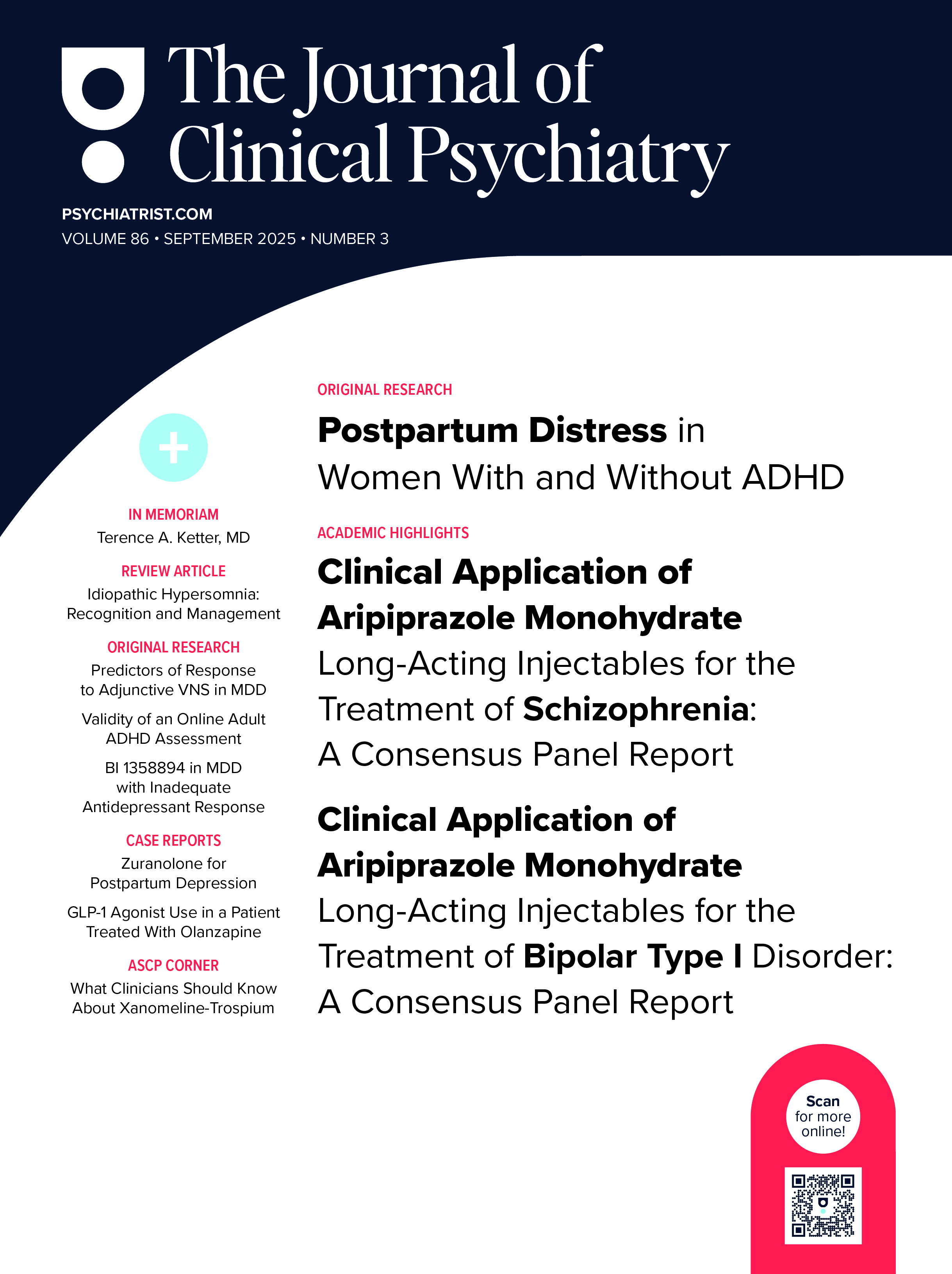Abstract
Objective: To evaluate factors associated with suicide mortality among Veterans Health Administration (VHA) patients with bipolar disorder.
Methods: VHA patients diagnosed with bipolar disorder in calendar year (CY) 2014 who utilized VHA health care services in CY2013 were included in the study cohort. Suicide mortality in the 5 years following the first documented bipolar disorder diagnosis during CY2014 was examined using Cox proportional hazards regression.
Results: 725 of 126,655 VHA patients who had a bipolar disorder diagnosis in CY2014 (0.6%) died by suicide in the following 5 CYs (2014–2019). Suicide was associated with suicide high-risk flags (hazard ratio [HR] = 2.21), prior year emergency department visit (HR = 1.25), having a new bipolar disorder diagnosis (HR= 1.23), and receiving a benzodiazepine prescription of ≥30 days of supply (HR = 1.58). Prescriptions of benzodiazepines of <30 days of supply, other anxiolytics (ie, buspirone), and sedatives were not significantly associated with suicide mortality in the multivariable model.
Conclusions: Among VHA patients diagnosed with bipolar disorder, receipt of a benzodiazepine prescription of ≥30 days was associated with increased suicide risk, even after controlling for clinical and demographic factors. Elucidating mechanisms through which benzodiazepine prescriptions increase suicide risk is an important avenue for future investigations. Additionally, VHA patients with newly diagnosed bipolar disorder may benefit from increased clinical attention, given the elevated suicide risk among this subgroup. Findings highlight targets for suicide prevention initiatives.
J Clin Psychiatry 2025;86(2):24m15424
Author affiliations are listed at the end of this article.
Members Only Content
This full article is available exclusively to Professional tier members. Subscribe now to unlock the HTML version and gain unlimited access to our entire library plus all PDFs. If you’re already a subscriber, please log in below to continue reading.
References (44)

- Veterans Health Administration. About VHA - Veterans Health Administration. 2023. Accessed June 22, 2023. https://www.va.gov/health/aboutvha.asp
- U.S. Department of Veterans Affairs. Fiscal Years 2022-28 Strategic Plan. 2022. Accessed April 3, 2023. https://www.va.gov/oei/docs/va-strategic-plan-2022-2028.pdf
- U.S. Department of Veterans Affairs. National Veteran Suicide Prevention Annual Report. Office of Mental Health and Suicide Prevention; 2023. Accessed June 30, 2023. https://www.mentalhealth.va.gov/suicide_prevention/data.asp.
- McCarthy JF, Bossarte RM, Katz IR, et al. Predictive modeling and concentration of the risk of suicide: implications for preventive interventions in the US Department of Veterans Affairs. Am J Public Health. 2015;105(9):1935–1942. PubMed CrossRef
- Kessler RC, Hwang I, Hoffmire CA, et al. Developing a practical suicide risk prediction model for targeting high-risk patients in the Veterans Health Administration. Int J Methods Psychiatr Res. 2017;26(3):e1575. PubMed
- Ilgen MA, Bohnert ASB, Ignacio RV, et al. Psychiatric diagnoses and risk of suicide in veterans. Arch Gen Psychiatry. 2010;67(11):1152–1158. PubMed CrossRef
- McCarthy JF, Ilgen MA, Austin K, et al. Associations between body mass index and suicide in the Veterans Affairs health system. Obes Silver Spring Md. 2014;22(1):269–276. PubMed CrossRef
- Shiner B, Peltzman T, Cornelius SL, et al. Recent trends in the rural–urban suicide disparity among veterans using VA health care. J Behav Med. 2021;44(4):492–506.
- Ilgen MA, McCarthy JF, Ignacio RV, et al. Psychopathology, Iraq and Afghanistan service, and suicide among Veterans Health Administration patients. J Consult Clin Psychol. 2012;80(3):323–330. PubMed CrossRef
- Nelson SM, Mach JJ, Hein TC, et al. Access to timely mental health care treatment initiation among Veterans Health Administration patients with and without serious mental illness. Psychol Serv. 2022;19(3):488–493.
- Conner KR, Bohnert AS, McCarthy JF, et al. Mental disorder comorbidity and suicide among 2.96 million men receiving care in the Veterans Health Administration health system. J Abnorm Psychol. 2013;122(1):256–263. PubMed CrossRef
- Smith EG, Austin KL, Kim HM, et al. Suicide risk in Veterans Health Administration patients with mental health diagnoses initiating lithium or valproate: a historical prospective cohort study. BMC Psychiatry. 2014;14(1):357. PubMed CrossRef
- Ahearn EP, Chen P, Hertzberg M, et al. Suicide attempts in veterans with bipolar disorder during treatment with lithium, divalproex, and atypical antipsychotics. J Affect Disord. 2013;145(1):77–82. PubMed CrossRef
- Katz IR, Rogers MP, Lew R, et al. Lithium treatment in the prevention of repeat suicide-related outcomes in veterans with major depression or bipolar disorder: a randomized clinical trial. JAMA Psychiatry. 2022;79(1):24–32. PubMed CrossRef
- Elixhauser A, Steiner C, Harris DR, et al. Comorbidity measures for use with administrative data. Med Care. 1998;36(1):8–27. PubMed CrossRef
- Hein TC, Peltzman T, Hallows J, et al. Suicide mortality among Veterans Health Administration care recipients with suicide risk record flags. Psychiatr Serv. 2022;73(3):259–264.
- Maynard C, Batten A, Liu CF, et al. The burden of mental illness among veterans: use of VHA health care services by those with service-connected conditions. Med Care. 2017;55(11):965–969. PubMed CrossRef
- Department of Veterans Affairs, Office of Mental Health and Suicide Prevention. Joint Department of Veterans Affairs and Department of Defense Mortality Data Repository. Data compiled from the National Death Index; 2023.
- Ilgen MA, Downing K, Zivin K, et al. Exploratory data mining analysis identifying subgroups of patients with depression who are at high risk for suicide. J Clin Psychiatry. 2009;70(11):1495–1500. PubMed CrossRef
- Case A, Deaton A. Rising morbidity and mortality in midlife among white non Hispanic Americans in the 21st century. Proc Natl Acad Sci U S A. 2015;112(49):15078–15083. PubMed CrossRef
- Katz IR, Dent KR, Morley SW, et al. Can “deaths of despair” serve as a focus for planning and evaluating clinical and preventive services for Veterans? Psychiatry Res. 2020;285:112841. PubMed CrossRef
- Fairman KA, Buckley K. Association of potential for deaths of despair with age and military service era. Mil Med. 2022;187(3–4):453–463.
- Pfeiffer PN, Ganoczy D, Ilgen M, et al. Comorbid anxiety as a suicide risk factor among depressed veterans. Depress Anxiety. 2009;26(8):752–757. PubMed CrossRef
- Dodds TJ. Prescribed benzodiazepines and suicide risk: a review of the literature. Prim Care Companion CNS Disord. 2017;19(2):22746.
- Deka R, Bryan CJ, LaFleur J, et al. Benzodiazepines, health care utilization, and suicidal behavior in Veterans with posttraumatic stress disorder. J Clin Psychiatry. 2018;79(6):17m12038. PubMed
- Gibson CJ, Li Y, Jasuja GK, et al. Long-term psychoactive medications, polypharmacy, and risk of suicide and unintended overdose death among midlife and older women Veterans. J Gen Intern Med. 2022;37(suppl 3):770–777.
- Smith A, Goulet JL, Vlahov D, et al. Risk factors for suicide among veterans living with and without HIV: a nested case-control study. AIDS Behav. 2024;28(1):115–124.
- Cooper SA, Szymanski BR, Karel MJ, et al. Suicide among Veterans receiving Veterans Health Administration Home Based Primary Care and following discharge from Community Living Centers. Suicide Life Threat Behav. 2021;51(6):1055–1066.
- Bernardy NC, Friedman MJ, Lund BC. Deimplementation of benzodiazepine prescribing in posttraumatic stress disorder in the Veterans Health Administration. J Clin Psychiatry. 2022;83(3):21m14128. PubMed
- Wells DL, Popish S, Kay C, et al. VA academic detailing service: implementation and lessons learned. Fed Pract. 2016;33(5):38–42.
- Sandbrink F, Oliva EM, McMullen TL, et al. Opioid prescribing and opioid risk mitigation strategies in the Veterans Health Administration. J Gen Intern Med. 2020;35(suppl 3):927–934. PubMed CrossRef
- Proudfoot JG, Parker GB, Benoit M, et al. What happens after diagnosis? Understanding the experiences of patients with newly-diagnosed bipolar disorder. Health Expect. 2009;12(2):120–129. PubMed CrossRef
- Fischer EP, McCarthy JF, Ignacio RV, et al. Longitudinal patterns of health system retention among Veterans with schizophrenia or bipolar disorder. Community Ment Health J. 2008;44(5):321–330. PubMed CrossRef
- McCarthy JF, Blow FC, Valenstein M, et al. Veterans Affairs Health System and mental health treatment retention among patients with serious mental illness: evaluating accessibility and availability barriers. Health Serv Res. 2007;42(3 Pt 1):1042–1060. PubMed CrossRef
- Abraham KM, Mach J, Visnic S, et al. Enhancing treatment reengagement for veterans with serious mental illness: evaluating the effectiveness of SMI Re Engage. Psychiatr Serv. 2018;69(8):887–895. PubMed CrossRef
- Smith SN, Lai Z, Almirall D, et al. Implementing effective policy in a national mental health re-engagement program for Veterans. J Nerv Ment Dis. 2017;205(2):161–170. PubMed
- Nock MK, Hwang I, Sampson N, et al. Cross-national analysis of the associations among mental disorders and suicidal behavior: findings from the WHO World Mental Health Surveys. PLoS Med. 2009;6(8):e1000123. PubMed CrossRef
- Zhang Y, Conner KR, Phillips MR. Case-control study in China of risk factors for suicide in men with alcohol use disorders. J Stud Alcohol Drugs. 2012;73(1):15–20. PubMed CrossRef
- Flensborg-Madsen T, Knop J, Mortensen EL, et al. Alcohol use disorders increase the risk of completed suicide — irrespective of other psychiatric disorders. A longitudinal cohort study. Psychiatry Res. 2009;167(1–2):123–130. PubMed CrossRef
- Marques L, Robinaugh DJ, LeBlanc NJ, et al. Cross-cultural variations in the prevalence and presentation of anxiety disorders. Expert Rev Neurother. 2011;11(2):313–322. PubMed CrossRef
- Kawa I, Carter JD, Joyce PR, et al. Gender differences in bipolar disorder: age of onset, course, comorbidity, and symptom presentation. Bipolar Disord. 2005;7(2):119–125. PubMed CrossRef
- Steenkamp MM, Boasso AM, Nash WP, et al. PTSD symptom presentation across the deployment cycle. J Affect Disord. 2015;176:87–94. PubMed CrossRef
- Miller TR, Swedler DI, Lawrence BA, et al. Incidence and lethality of suicidal overdoses by drug class. JAMA Netw Open. 2020;3(3):e200607. PubMed CrossRef
- Milner A, Witt K, Maheen H, et al. Access to means of suicide, occupation and the risk of suicide: a national study over 12 years of coronial data. BMC Psychiatry. 2017;17(1):125 PubMed CrossRef






